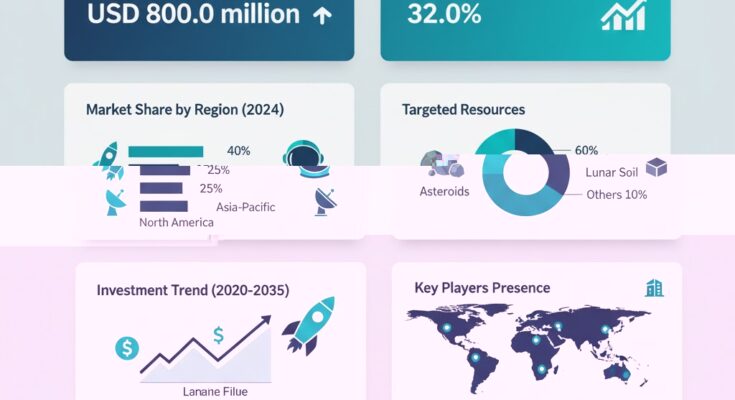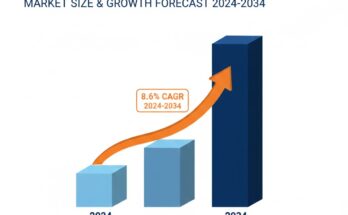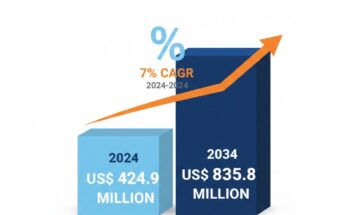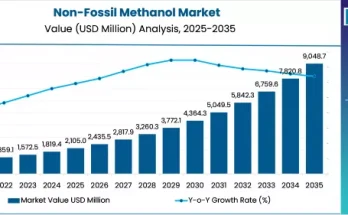The global space mining market is entering an era of exponential growth, driven by rising investments in extraterrestrial exploration, advancements in spacecraft technology, and the increasing need for rare minerals and water from celestial bodies. According to a recent report by Fact.MR, the market is projected to grow from USD 50.0 million in 2025 to approximately USD 800.0 million by 2035, recording an absolute increase of USD 750.0 million. This translates into an impressive compound annual growth rate (CAGR) of 32.0% between 2025 and 2035.
As global demand for energy and rare earth elements intensifies, space mining—once considered science fiction—is rapidly transforming into a viable industry. Driven by breakthroughs in propulsion systems, robotic automation, and orbital logistics, companies and space agencies are racing to tap into the vast mineral wealth of asteroids, the Moon, and Mars.
Market Drivers: Resource Scarcity, Technological Advancements, and Strategic Space Exploration
Rising Demand for Rare Earth Elements and Metals
The global technology and renewable energy sectors rely heavily on rare earth elements (REEs) such as platinum, palladium, cobalt, and neodymium—resources that are increasingly scarce on Earth. Asteroids and lunar surfaces are believed to contain vast deposits of these materials, which can support sustainable industrial development and clean energy initiatives.
Technological Innovations in Spacecraft and Robotics
Next-generation mining technologies—such as autonomous excavation systems, AI-powered robotics, and reusable launch vehicles—are reducing mission costs and operational risks. Companies like SpaceX and Blue Origin are pioneering reusable rocket systems, enabling frequent and affordable access to near-Earth objects (NEOs) for prospecting missions.
Government Support and International Collaborations
National space agencies and private enterprises are forming alliances to explore extraterrestrial mining possibilities. The U.S. Artemis Program, Japan’s ispace lunar missions, and European Space Agency (ESA) partnerships are accelerating regulatory frameworks and technical feasibility studies. Supportive policies promoting private sector participation are paving the way for commercialization in the next decade.
Shift Toward Sustainable and Strategic Resource Utilization
Beyond commercial profits, space mining offers a solution to Earth’s depleting mineral reserves and the growing need for sustainable resources. Extracted materials such as water ice can be converted into rocket fuel, supporting in-space refueling stations and long-duration missions to Mars and beyond. This approach aligns with the global transition toward a space-based economy emphasizing circular resource utilization and off-world manufacturing.
Competitive Landscape
The space mining market is highly competitive and innovation-driven, with leading players focusing on mission feasibility, resource mapping, and extraction technology development.
Key Players in the Space Mining Market:
- Planetary Resources Inc.
- Deep Space Industries Inc.
- Moon Express Inc.
- ispace Inc.
- Astroscale Holdings Inc.
- Blue Origin LLC
- Space Exploration Technologies Corp. (SpaceX)
- NASA Contractors
- Roscosmos State Corporation
- ESA Partners (European Space Agency collaborators)
- OffWorld Inc.
- TransAstra Corporation
- Orbit Fab Inc.
- Shackleton Energy Company
These organizations are exploring diverse strategies—from developing asteroid capture systems to refining lunar regolith extraction techniques—to establish early dominance in this emerging sector.
Recent Developments
- August 2025 – NASA announced the approval of its “Asteroid Resource Prospecting Mission” aimed at testing robotic extraction on near-Earth asteroids by 2028.
- May 2024 – ispace Inc. successfully launched its second lunar mission, carrying payloads for water-ice prospecting and surface mapping.
- February 2024 – Orbit Fab Inc. unveiled its “Gas Stations in Space” initiative, establishing orbital refueling depots to support future mining and logistics operations.
Segmentation of the Space Mining Market
The space mining market is segmented across various operational and technological dimensions to capture its complex ecosystem:
- By Target Body: Asteroids, Moon, and Mars
- By Resource Type: Water/Ice, Metals & Minerals, and Construction Materials
- By Mission Type: Exploration, Extraction, and In-Space Processing
- By End Use: Aerospace Manufacturing, Fuel Production, and Scientific Research
- By Region: North America, Europe, East Asia, South Asia & Pacific, Latin America, and the Middle East & Africa
North America leads the market with strong government funding and commercial participation. Europe is advancing rapidly with ESA-supported missions, while Asia-Pacific is emerging as the fastest-growing region, driven by Japan’s and India’s lunar initiatives.
Future Outlook: Building a Space Economy
By 2035, space mining will evolve from conceptual exploration to commercial extraction. The next decade will see:
- AI-Enabled Prospecting: Intelligent mapping and autonomous drilling on asteroids and lunar surfaces.
- In-Situ Resource Utilization (ISRU): On-site material conversion for building space habitats and refueling missions.
- Reusable Launch Systems: Dramatic cost reductions through reusable rocket technologies.
- Global Collaboration: Strategic partnerships among nations, research institutes, and private companies to establish space resource governance.
As the space economy matures, space mining will redefine how humanity sources and manages resources, marking a new frontier in industrial and technological advancement.



